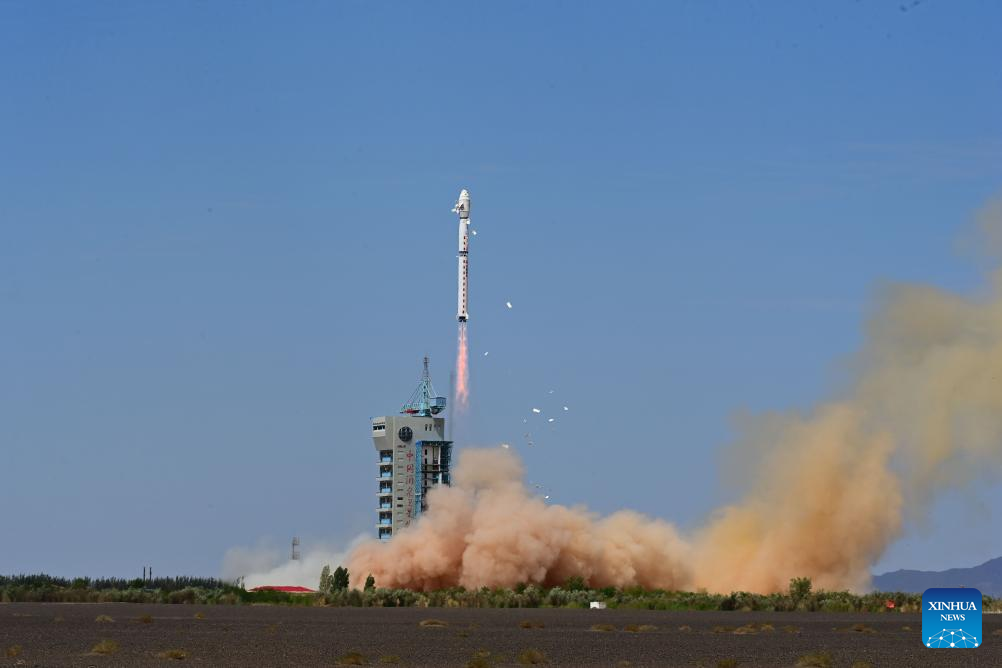China Focus: China launches FY-3F meteorological satellite
Source: Xinhua | 2023-08-04 | Editor:Ines

A Long March-4C rocket carrying the Fengyun-3 06 satellite blasts off from the Jiuquan Satellite Launch Center in northwest China, Aug. 3, 2023. The launch marked the 481st flight mission of the Long March series carrier rockets. (Photo by Wang Jiangbo/Xinhua)
China on Thursday launched a satellite into space from the Jiuquan Satellite Launch Center in northwest China.
The Fengyun-3F (FY-3F) satellite was launched at 11:47 a.m. (Beijing Time) by a Long March-4C carrier rocket and successfully entered the planned orbit.
The satellite was developed by the Shanghai Academy of Spaceflight Technology (SAST) under the China Aerospace Science and Technology Corporation, and its ground application system is operated by the China Meteorological Administration (CMA).
As a meteorological satellite with load configuration and performance indicators that have reached the international advanced level, FY-3F will take over the in-orbit duties of the FY-3C satellite and provide services in areas such as weather forecasting, climate prediction, disaster monitoring, and environmental monitoring.
The new satellite is equipped with an advanced microwave thermometer, a microwave hygrometer and an infrared hyperspectral atmospheric detector, said Li Haisheng with the SAST, who is in command of the satellite mission.
Compared with FY-3C, the number of atmospheric vertical detection channels provided by FY-3F is up by over 40 times, which means that the new satellite will have a more accurate understanding of atmospheric temperature and humidity stratification, Li said.
By combining microwave and optical atmospheric detection instruments, FY-3F can detect atmospheric temperature and humidity profile information that is difficult to distinguish by the human eye, allowing it to conduct more accurate three-dimensional scanning of the atmosphere, so that typhoons and rainstorms can be effectively traced.
The new satellite will further improve the timeliness and accuracy of weather forecasting and make greater contributions to disaster prevention and reduction, said Chen Zhenlin, head of the CMA.
FY-3F also features dynamic monitoring of the spatiotemporal distribution characteristics and changing trends of global atmospheric trace gases, which it achieves with high precision and high frequency.
In addition, FY-3F has an upgraded ultraviolet detection capability, and is equipped with two newly developed ultraviolet hyperspectral remote sensing detectors, said Wang Jinhua with the SAST. Wang is the chief designer of the satellite.
From the detectors, researchers can obtain useful information for climate change, atmospheric chemistry and atmospheric environment research.
Currently, there are nine Fengyun meteorological satellites in orbit, providing data products and services for 129 countries and regions around the world.
You May Like
-
Chinese commercial space company launches satellite with fle...
A Chinese commercial space company on Sunday launched a Long March-2D rocket, placing the Lingxi-03 satellite into preset orbit.
InKunming 2023-07-24 -
China launches new satellite to test satellite internet tech...
China on Sunday sent a new test satellite into space from the Jiuquan Satellite Launch Center in northwest China.
InKunming 2023-07-10 -
China Focus: China launches record-setting 41 satellites on ...
China launched a Long March-2D rocket to place 41 satellites in orbit on Thursday, setting a domestic record for the most satellites lifted in one go.
InKunming 2023-06-16 -
China launches "Macao Science 1" space exploration satellite...
China successfully sent two satellites of "Macao Science 1," a space exploration program, into space on Sunday.
InKunming 2023-05-22 -
China launches new experiment satellite
China on Wednesday evening successfully sent a new experiment satellite into space from the Jiuquan Satellite Launch Center in northwest China.
InKunming 2023-03-16 -
China launches new communications satellite
China on Thursday sent a new communications satellite into orbit from the Xichang Satellite Launch Center in southwest China's Sichuan Province.
InKunming 2023-02-24 -
China launches Yaogan 34 remote sensing satellite
China successfully sent a new remote sensing satellite of the Yaogan 34 series into space from the Jiuquan Satellite Launch Center in Northwest China at 9:38 am...
InKunming 2022-11-15 -
GLOBALink | China-aided project helps 100,000 people in rura...
completed the installation of the satellite television project in 900 Ugandan villages that face connectivity challenges. More than 100
InKunming 2022-10-18 -
China launches Zhongxing-1E satellite
China successfully sent a new satellite into space from the Wenchang Spacecraft Launch Site in the southern island province of Hainan on Tuesday.
InKunming 2022-09-14 -
China launches 16 new satellites
China on Wednesday sent 16 new satellites into space from the Taiyuan Satellite Launch Center in the northern province of Shanxi.
InKunming 2022-08-11







